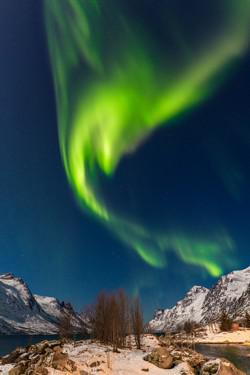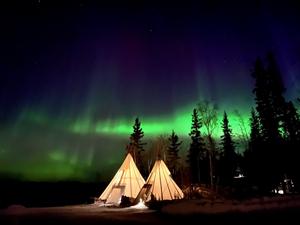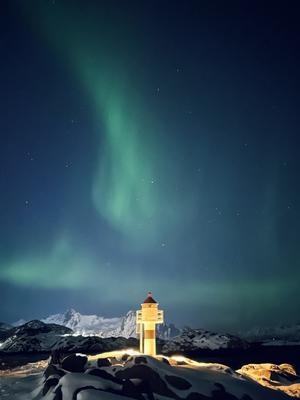Glossarbegriffe: Polarlicht
Description: Ein Polarlicht ist eine diffuse, farblich unterschiedliche Leuchterscheinungen in der Erdatmosphäre, das hauptsächlich in den Polarregionen auftritt. Im Norden ist es als Nordlicht oder Aurora borealis bekannt, im Süden als Südlicht oder Aurora australis.
Polarlichter variieren in ihrer Farbe von grünlich-weiß bis rot, treten hauptsächlich in Höhen von etwa 100 Kilometern auf und bilden sich um zwei unregelmäßige Polarlicht-Ovale, die auf den Magnetpolen der Erde zentriert sind. Sie entstehen, wenn geladene Teilchen aus dem Sonnenwind oder koronalen Massenauswürfen (CMEs) in der Magnetosphäre der Erde eingefangen werden, durch Magnetfelder in der oberen Atmosphäre konzentriert werden und spiralförmig entlang der Magnetfeldlinien der Erde in Richtung der Pole wandern. Die Wechselwirkungen dieser geladenen Teilchen mit Atomen und Molekülen in der Atmosphäre führen zu den Polarlichterscheinungen. In Zeiten hoher Sonnenaktivität gibt es verstärkt Polarlichter. Auch auf anderen Planeten des Sonnensystems sind bereits Polarlichter beobachtet worden, insbesondere auf Jupiter und Saturn.
Zugehörige Glossarbegriffe:
See this term in other languages
Term and definition status: The original definition of this term in English have been approved by a research astronomer and a teacher The translation of this term and its definition is still awaiting approval
The OAE Multilingual Glossary is a project of the IAU Office of Astronomy for Education (OAE) in collaboration with the IAU Office of Astronomy Outreach (OAO). The terms and definitions were chosen, written and reviewed by a collective effort from the OAE, the OAE Centers and Nodes, the OAE National Astronomy Education Coordinators (NAECs) and other volunteers. You can find a full list of credits here. All glossary terms and their definitions are released under a Creative Commons CC BY-4.0 license and should be credited to "IAU OAE".
Zugehörige Medien
Till the End of the World, by Hang Li, China
Bildnachweis: Hang Li/IAU OAE
License: CC-BY-4.0 Creative Commons Namensnennung 4.0 International (CC BY 4.0) icons
Under the Stars with Steve, by Sheila Wiwchar, Canada
Bildnachweis: Wiwchar, Sheila; IAU OAE
License: CC-BY-4.0 Creative Commons Namensnennung 4.0 International (CC BY 4.0) icons
Icelandic Rivers of Light, by Sergio Díaz Ruiz, Spain
Bildnachweis: Sergio Díaz Ruiz/IAU OAE
License: CC-BY-4.0 Creative Commons Namensnennung 4.0 International (CC BY 4.0) icons
Multicolored aurora in Iceland, by Marco Migliardi on behalf of Associazione Astronomica Cortina, Italy
Bildnachweis: Marco Migliardi on behalf of Associazione Astronomica Cortina/IAU OAE.
License: CC-BY-4.0 Creative Commons Namensnennung 4.0 International (CC BY 4.0) icons
Northern light dragon over Ersfjordbotn/Norway
Bildnachweis: Rainer Sparenberg/IAU OAE
License: CC-BY-4.0 Creative Commons Namensnennung 4.0 International (CC BY 4.0) icons
Iceland aurora, by Emanuele Balboni, Italy
Bildnachweis: Emanuele Balboni/IAU OAE
License: CC-BY-4.0 Creative Commons Namensnennung 4.0 International (CC BY 4.0) icons
Northern Lights - Teepees
Bildnachweis: Oanh Vuong/IAU OAE (CC BY 4.0)
License: CC-BY-4.0 Creative Commons Namensnennung 4.0 International (CC BY 4.0) icons
The Big Dipper in the Polar Night
Bildnachweis: Stephanie Ziyi Ye/IAU OAE (CC BY 4.0)
License: CC-BY-4.0 Creative Commons Namensnennung 4.0 International (CC BY 4.0) icons
Fire of the Sky
Bildnachweis: Stephanie Ziyi Ye/IAU OAE (CC BY 4.0)
License: CC-BY-4.0 Creative Commons Namensnennung 4.0 International (CC BY 4.0) icons
Northern Lights Color
Bildnachweis: Jason Johnson/IAU OAE (CC BY 4.0)
License: CC-BY-4.0 Creative Commons Namensnennung 4.0 International (CC BY 4.0) icons


















